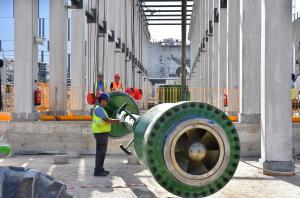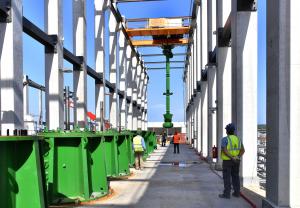Heat removal
Moving 10 tonnes of water per second
23 Sep 2019
If ITER were a fusion power plant, the amount of heat produced by the machine would be partly absorbed by the steam generators and turbines that initiate the electricity-generating process. But ITER is neither a fusion power plant nor a steady-state device: it is an experimental machine designed to demonstrate the technical feasibilityof fusion energy. As it will operate in pulses, the heat production will only occur during relatively brief plasma shots (between five minutes and one hour depending on the regime). And the totality of the heat generated will need to be evacuated, requiring a properly designed heat rejection system.
The installation of 10-metre long shafts for the 13 vertical turbine pumps is underway now. Each pump is designed to move one tonne of water per second.
Burning plasmas are not the only source of heat in the ITER installation. The compressors and cold boxes in the cryoplant, the transformers and converters in the magnet power conversion buildings, the power supply for the neutral beam injectors ... all this equipment produces significant quantities of heat (although not comparable to that produced inside the ITER Tokamak) that must be extracted at all times through a vast cooling water network comprising kilometres of piping, dozens of pumps, and several thousand valves.
Whatever its source, the cooling water ends up in two 10,000-cubic-metre basins: one "hot," where water is stored before being cooled in the induced-draft cooling tower, and one "cold," which receives the cooled water as it leaves the cooling tower.
The amount of water that needs to be circulated within this system is huge—in the range of 10 cubic metres per second. A set of 13 vertical turbine pumps, submerged deep in the basins, are tasked to move up to one tonne of water per second per pump.
The six-tonne component must be perfectly positioned and balanced to withstand the considerable forces that the rotation of the impeller and the flux of water exert. Horizontal deflection at the bearings cannot exceed 0.05 millimetre.
Three of them are dedicated to recirculating the water from the hot basin to the cold basin and balancing the peaks of heat generated by the plasma pulses. Six circulate water from the cold basin through the heat exchangers that receive the heat load from the Tokamak and dump it into the hot basin. Finally, four pumps cool the heat exchangers that take in cooling water from other parts of the installation (cryogenic systems, electric power supplies, etc.).
Installation of the vertical turbine pumps began last week with the insertion, in each pump housing, of the 10-metre-long shaft that will connect the rotor (or impeller) to a powerful 870 kW electrical motor.
In order to withstand the considerable forces that the rotation of the impeller and the flux of water will exert, the component must be perfectly positioned and balanced. The shaft, bearings and impeller are manufactured within 100 microns of tolerance. At the bearings, horizontal deflection cannot exceed 0.05 mm.
Ten shafts are now installed. And the horizontal deflection does not exceed 0.03 millimetres ...



